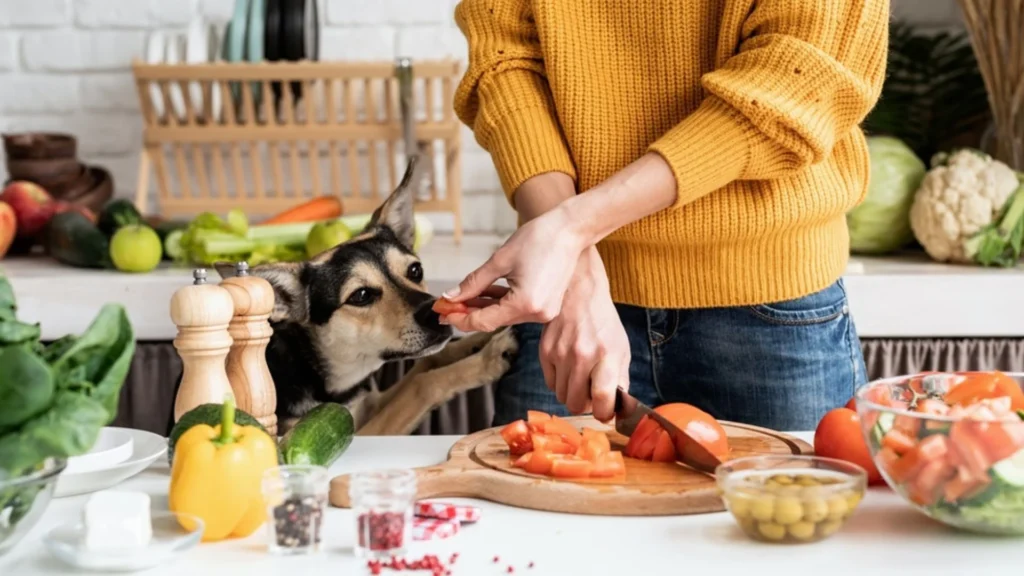Feeding your dog a homemade diet is one of the most personal and health-conscious choices you can make as a pet owner.
But while crafting meals from scratch offers control over ingredients and quality, it also introduces a critical challenge: how much to feed homemade dog food?
A commercial kibble or canned food, homemade meals don’t come with feeding guidelines printed on the label.
This comprehensive guide will help you determine the right portion sizes, balance nutrients, and ensure your dog thrives on a homemade diet.
How Much To Feed Homemade Dog Food?
When figuring out how much homemade food to give your dog, a good rule of thumb is to feed 2-3% of their body weight each day.
This serves as a starting point, but the ideal portion can vary based on your dog’s breed, lifestyle, and nutritional needs.
Always check with your vet or a pet nutrition expert to tailor the diet to your dog’s individual health requirements.
Why Portion Control Matters in Homemade Dog Food
Portion control is crucial when feeding your dog homemade food because it ensures they receive the right amount of calories and nutrients for their size, age, and activity level.
Commercial dog food, homemade meals don’t come with pre-measured feeding instructions, making it easy to overfeed or underfeed.
Overfeeding can lead to obesity and related health problems, while underfeeding may cause nutrient deficiencies and low energy.
Proper portioning helps maintain a healthy weight, supports overall well-being, and ensures your dog gets the balanced nutrition they need to thrive.

Homemade Dog Food Serving Size Calculator?
An easy way to estimate how much homemade food to serve your dog is by using 2-3% of their body weight as a daily guideline.
So, a 50-pound dog would typically eat between 1 and 1.5 pounds of food each day. Keep in mind, every dog is different factors like age, metabolism, and exercise levels play a big role.
For the best results, adjust portions as needed and check with your vet to ensure your dog’s nutritional needs are fully met.
How Much Homemade Dog Food To Feed 70 Lb Dog?
A 70-pound dog typically needs about 3 to 3¾ cups of homemade food daily, but this estimate can vary. Factors like your dog’s energy level, age, and overall health can influence how much food they truly need.
Monitoring their weight and condition over time can help you fine-tune their portions. For the most accurate feeding plan, consult with your vet to ensure your dog is getting the right nutrients in the right amounts.
How To Make Balanced Homemade Dog Food?
Making balanced homemade dog food involves including the right mix of proteins, carbohydrates, fats, vitamins, and minerals to meet your dog’s nutritional needs.
Start with a high-quality protein source like chicken, beef, or fish. Add healthy carbohydrates such as rice, sweet potatoes, or oats for energy. Include vegetables like carrots, peas, or spinach for fiber and vitamins.
Don’t forget healthy fats from sources like fish oil or flaxseed. It’s important to incorporate supplements like calcium and multivitamins recommended by your veterinarian or a pet nutritionist to ensure the diet is complete and safe.
Always consult a professional before making homemade food your dog’s main diet to keep them healthy and thriving.
What Is The Correct Ratio For Homemade Dog Food
The generally recommended ratio for homemade dog food is about 40% protein, 50% vegetables, and 10% carbohydrates or starches.
This balance helps provide essential nutrients like amino acids, fiber, vitamins, and energy. However, the exact ratio can vary depending on your dog’s age, breed, activity level, and health needs.
To ensure your dog’s diet is fully balanced and safe, it’s best to consult with a veterinarian or a pet nutritionist who can tailor the ratio specifically for your dog.
Is Homemade Dog Food Enough Nutrition?
Homemade dog food can provide enough nutrition if it’s carefully planned and balanced to meet all of your dog’s dietary needs.
Simply cooking meat and veggies isn’t always enough, because dogs require specific nutrients like certain vitamins, minerals, and amino acids in the right amounts.
Without proper balance, homemade meals might lead to deficiencies or excesses that can harm your dog’s health over time.
That’s why it’s important to work with a veterinarian or pet nutritionist to create recipes that cover all nutritional bases and include any necessary supplements. When done right, homemade food can be a healthy, wholesome option for your dog.
When to Talk to a Vet or Canine Nutritionist
- Your dog has a medical condition or food allergies.
- You’re unsure about balancing homemade recipes.
- Your dog is gaining/losing weight unexpectedly.
- You want to create a long-term feeding plan.
A certified veterinary nutritionist can design a custom meal plan based on your dog’s profile and provide exact amounts to feed.
FAQs About How Much To Feed Homemade Dog Food
How do I know how much homemade dog food to feed my dog?
To determine the right amount, calculate your dog’s daily calorie needs based on their weight, age, and activity level, then portion your homemade food according to its calorie content. A good starting point is to feed about 2-3% of your dog’s ideal body weight in homemade food daily, adjusting as needed based on their body condition and energy.
Can I feed my dog too much homemade food?
Yes. Overfeeding homemade dog food can lead to weight gain and health issues just like commercial food. Even healthy ingredients contain calories, so measuring portions carefully and monitoring your dog’s weight regularly is essential.
How often should I feed homemade dog food each day?
Most adult dogs do well with two meals per day. Feeding smaller, more frequent meals can help digestion and energy levels, but twice daily is typical for homemade diets unless otherwise recommended by your vet.
Should I feed the same amount every day?
Your dog’s needs can fluctuate with activity, age, and health status, so portion sizes may need periodic adjustment. Regularly assess your dog’s body condition and weight, and adjust the amount of homemade food accordingly.
What if my dog refuses to eat the calculated amount of homemade food?
Some dogs may initially resist changes or feel full quickly. Try mixing homemade food with a bit of their previous diet, warming the food slightly, or changing the recipe’s texture. If your dog consistently refuses meals or loses weight, consult your vet.
Final Thoughts
Feeding your dog homemade food can greatly improve their health, happiness, and longevity—but it requires commitment and precision. Start with understanding your dog’s nutritional needs, calculate the right amount of food based on their weight and lifestyle, and monitor their condition regularly.
With proper planning and a little guidance, you can provide delicious, nutritious meals your dog will love and that will help them thrive for years to come.

Hello dog lovers, I am John. Welcome to my website healthydogfoods.com. I am happy to gain experience from my love for my dog and my pet dog. Through my experience and acquaintance with dog veterinarians, I have made myself a proper guide for dogs. I will tell you about dog care, their nutritious food, their proper safety and dog upbringing for a better life. Even though dogs cannot talk like humans, I will solve all the problems by observing their behavior. I will discuss the proper care and related issues of your dog. Which will give you the right answer to all the problems of your beloved dog.